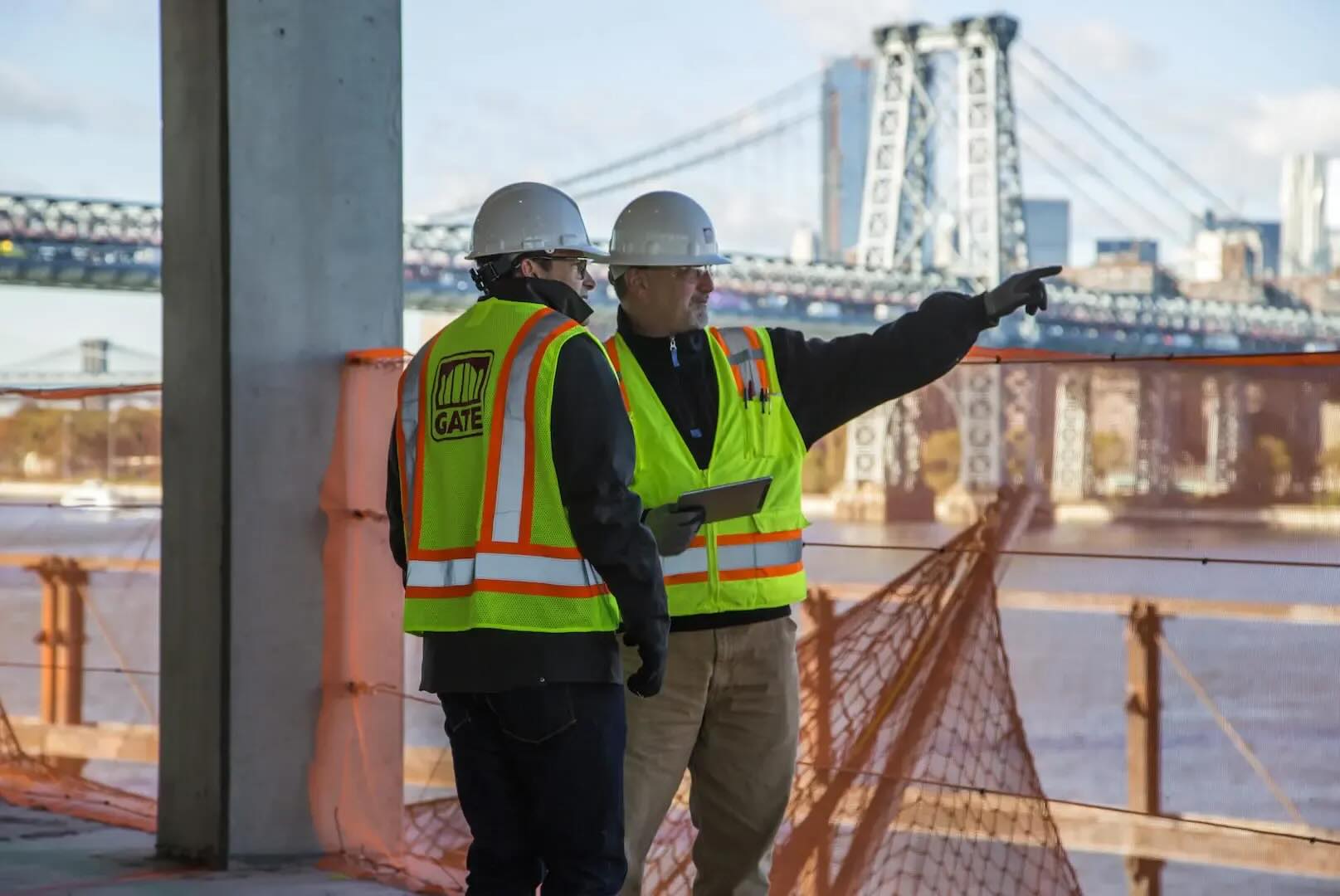Home>diy>Building & Construction>What Is A Change Order In Construction


Building & Construction
What Is A Change Order In Construction
Modified: January 6, 2024
Discover what a change order is in the realm of building construction. Gain valuable insights to help you navigate this crucial aspect of your construction project.
(Many of the links in this article redirect to a specific reviewed product. Your purchase of these products through affiliate links helps to generate commission for Storables.com, at no extra cost. Learn more)
Introduction
Welcome to the world of construction, where every project comes with its unique set of challenges and adjustments. Construction projects are complex endeavors that require careful planning, coordination, and execution. However, even with the most meticulous planning, changes can and do happen during the course of a construction project. These changes can range from minor adjustments to major modifications that can have a significant impact on the project’s timeline, budget, and scope.
In order to effectively manage these changes, the construction industry relies on a tool known as a change order. Change orders play a crucial role in facilitating flexibility and adaptability within construction projects. They allow for modifications to be made to the original contract or plans, ensuring that any necessary adjustments are properly documented, approved, and implemented.
In this article, we will explore the concept of change orders in construction, their purpose, and the importance of managing them effectively. We will also discuss the reasons for change orders, the process of requesting and approving them, as well as the impacts they can have on construction projects. Finally, we will delve into best practices for handling change orders and offer some tips on how to effectively manage and mitigate their impact.
Whether you’re a homeowner planning a small renovation project or a project manager overseeing a large-scale construction endeavor, understanding the ins and outs of change orders is essential. So, let’s dive in and demystify this vital aspect of the construction process.
Key Takeaways:
- Change orders are essential in construction, providing flexibility, documentation, and risk mitigation. They allow for adjustments to the original scope of work, ensuring project success and client satisfaction.
- Effective change order management involves clear procedures, thorough evaluation, communication, and learning from experience. It balances flexibility and accountability, contributing to successful construction projects.
Definition of a Change Order
A change order, in the context of construction, refers to a written document that outlines modifications or additions to the original scope of work outlined in the contract. It serves as a formal request to alter specific aspects of the project, such as design, materials, schedule, or cost. Change orders are typically initiated when unforeseen circumstances arise, design changes are needed, or client preferences evolve throughout the construction process.
Change orders act as official documentation that outlines the changes being requested, including the reasons for the change, the cost implications, and any adjustments to the project timeline. These documents must be agreed upon and signed by all relevant parties, such as the client, contractor, and subcontractors, ensuring that everyone is aware of and in agreement with the proposed modifications.
Change orders are an essential part of the construction process, as they allow for flexibility and adaptability in the face of evolving project requirements. They help facilitate open communication between stakeholders and provide a mechanism to address unexpected challenges or enhance the project to meet the client’s evolving needs.
It’s important to note that change orders differ from regular project updates or minor adjustments, as they involve substantial changes to the original scope of work or contract terms. Minor adjustments, such as fixing a typo in the plans or swapping out a specific brand of materials, can often be addressed through simple project updates or revised drawings without the need for a formal change order.
Change orders serve as an important contractual tool, protecting both the client and the contractor by ensuring that all modifications to the project are documented, agreed upon, and properly executed. They help maintain transparency and accountability throughout the construction process, reducing the potential for disputes and misunderstandings between parties.
Now that we understand the definition and purpose of change orders, let’s explore why they are so crucial in the world of construction.
Purpose of Change Orders in Construction
The primary purpose of change orders in construction is to address modifications, adjustments, or additions to the original scope of work outlined in the contract. They provide a formal and structured process for documenting and implementing these changes, ensuring that all parties involved are aware of the modifications and their implications.
Change orders serve several important purposes:
- Flexibility and Adaptability: Construction projects are dynamic, and changes are often inevitable. Change orders allow for the necessary flexibility and adaptability to respond to unforeseen circumstances, design modifications, or evolving client needs. They provide a mechanism to make necessary adjustments while maintaining accountability and clear communication.
- Documentation and Record-Keeping: Change orders play a crucial role in documenting and recording any changes made throughout the project. They provide a paper trail of the modifications and ensure that all parties are on the same page regarding the revised scope, cost implications, and timeline adjustments. This documentation is vital in case of any disputes or discrepancies that may arise in the future.
- Cost Control and Budget Management: Change orders help maintain control over project costs by providing a clear process to evaluate and approve any additional expenses resulting from the requested changes. They outline the cost impacts and seek agreement on these adjustments before proceeding, ensuring that all parties are aware of the financial implications of the modifications.
- Risk Mitigation: Change orders play a role in mitigating risks by ensuring that any modifications or additions are properly evaluated and approved. The change order process allows project stakeholders to assess the potential impacts and consider any potential risks associated with the proposed changes, such as schedule delays, increased costs, or impact on quality.
- Client Satisfaction: Change orders allow clients to have a more active role in the construction process and provide an avenue to express their evolving needs and preferences. By addressing client requests through change orders, construction projects can align more closely with the client’s vision and ensure greater client satisfaction.
Overall, the purpose of change orders in construction is to facilitate effective communication, manage change in a structured manner, maintain project control, and ultimately deliver a successful project that meets the client’s needs and expectations.
Now that we understand the purpose of change orders, let’s explore why they are so important in the construction industry.
Importance of Change Orders in Construction
Change orders are of paramount importance in the construction industry for several reasons. They play a crucial role in ensuring the smooth execution of construction projects and maintaining the overall project integrity. Here are some key reasons why change orders are so important:
- Flexibility and Adaptability: Construction projects are dynamic and subject to various factors that can lead to necessary modifications. Change orders allow for flexibility and adaptability in responding to unforeseen circumstances and changing project requirements. They provide a mechanism to address these changes in a structured and documented way.
- Contractual Protection: Change orders act as official amendments to the original contract, protecting both the client and the contractor. They clearly define the changes being made, including any associated costs and schedule adjustments. By documenting these changes, change orders help prevent disputes and misunderstandings between parties, ensuring that both sides have a clear understanding of the modified project scope.
- Budget Control: Change orders play a vital role in managing project budgets. They allow for the proper evaluation and approval of any additional costs resulting from changes. This helps maintain control over project expenditures by ensuring that all parties are aware of the financial implications before proceeding with the modifications.
- Time Management: Change orders help manage project timelines by clearly defining any schedule adjustments resulting from the requested changes. By documenting these modifications, all parties involved can evaluate and plan accordingly to accommodate the revised timeline. This helps minimize delays and ensures that the project proceeds smoothly.
- Quality Assurance: Change orders ensure that any changes made during the construction process are properly evaluated to maintain the desired quality standards. They provide an opportunity to assess the impact of modifications on the overall project’s quality and make any necessary adjustments to uphold the project’s integrity and meet the client’s expectations.
- Client Satisfaction: Change orders enable clients to have a more active role in the construction process. By addressing client requests and evolving needs through change orders, construction projects can align more closely with the client’s vision and requirements. This enhances client satisfaction and strengthens the client-contractor relationship.
- Project Transparency: Change orders promote open communication and transparency between all project stakeholders. By formally documenting and approving changes, change orders ensure that everyone involved is aware of the modifications and their implications. This transparency fosters trust, establishes clear expectations, and minimizes miscommunication throughout the construction process.
With the complex nature of construction projects, change orders offer a structured and systematic approach to address modifications while maintaining project control. By embracing change orders, construction professionals can effectively manage project changes, mitigate risks, and deliver successful projects that meet client expectations.
Having explored the importance of change orders, let’s dive deeper into the reasons that often necessitate change orders in construction projects.
Reasons for Change Orders in Construction
Change orders in construction projects are often required due to a variety of factors that can arise throughout the course of a project. These factors can be categorized into several common reasons for change orders:
- Design Modifications: One of the most common reasons for change orders is a design modification. As the construction progresses, it is not uncommon for stakeholders to realize that certain aspects of the original design need to be altered. This can be due to changes in functional requirements, aesthetic preferences, or unforeseen technical challenges that emerge during the construction process.
- Unforeseen Conditions: Sometimes, once construction begins, unforeseen conditions such as hidden structural issues or outdated infrastructure are discovered. These unexpected conditions may require changes to the original plans or specifications. Change orders are necessary to address these unforeseen conditions and ensure that the project can proceed smoothly and safely.
- Client Requests: Clients’ needs, preferences, and priorities can evolve throughout the construction process. As they gain a better understanding of the project or encounter new ideas, clients may request changes to the original scope of work. These requests can range from minor adjustments to major modifications, and change orders provide the mechanism to formalize these client-driven changes.
- Regulatory or Code Compliance: Construction projects must adhere to various regulatory requirements and building codes. If changes in these regulations occur during the course of a project, it may necessitate adjustments to the original plans or specifications. Change orders are used to address these regulatory or code compliance issues and ensure that the project meets all necessary standards.
- Scope Creep: Scope creep refers to the gradual expansion of the project scope beyond the original agreement. It can occur due to ambiguous project specifications, changing requirements, or additional requests from the client. Change orders are crucial for managing scope creep by officially documenting any changes or additions to the project scope and ensuring that all parties are aware of the impacts on cost and schedule.
- Material or Equipment Availability: Construction projects rely on the availability of materials and equipment. Delays or unavailability of specific materials or equipment outlined in the original plans may necessitate changes in order to keep the project moving forward. Change orders are used to address these issues and identify suitable alternatives or substitutions.
- Cost Adjustments: Construction projects are subject to cost fluctuations due to various factors such as market conditions, changes in material prices, or unforeseen challenges. Change orders provide a mechanism to adjust the project’s budget and address any additional costs resulting from the requested changes. They ensure that all parties are aware of the financial implications of modifications and can make informed decisions.
These are just some of the common reasons for change orders in construction projects. By recognizing and addressing these factors through change orders, stakeholders can effectively manage modifications, maintain project control, and ensure the successful completion of the project.
Now that we understand the reasons for change orders, let’s explore the process of requesting and implementing these changes in construction projects.
Read more: How Do Change Orders Work In Construction
Process of Requesting a Change Order
The process of requesting a change order in construction involves several important steps to ensure that changes to the original project scope are properly evaluated, documented, and implemented. Here is a typical process for requesting a change order:
- Identification of Change: The first step in requesting a change order is identifying the need for a modification to the original project scope. This can be initiated by the client, the contractor, or any other project stakeholder. It is important to clearly define the nature of the change and its impact on the project, including any associated costs, schedule adjustments, or potential risks.
- Change Request Documentation: Once the change has been identified, it is essential to document the proposed modification in writing. This documentation should include a description of the change, the reasons for the change, and any supporting information or justifications. It is crucial to be as detailed and specific as possible to ensure a clear understanding of the requested change.
- Cost and Schedule Evaluation: The next step is to evaluate the cost and schedule implications of the proposed change. This involves assessing the additional resources, materials, labor, and time required to implement the change. A thorough analysis should be conducted to determine the financial impact of the change and any adjustments needed to the project timeline.
- Change Order Submission: Once the change request has been documented and the cost and schedule impacts have been evaluated, a formal change order should be prepared. This document should outline the proposed change, including any revised plans, drawings, or specifications. It should also include the cost implications, schedule adjustments, and any other relevant information. The change order should be signed and submitted to all relevant parties, such as the client, contractor, and subcontractors.
- Review and Approval: Once the change order has been submitted, it goes through a review and approval process. All stakeholders involved in the project, including the client, contractor, and any other relevant parties, should review the proposed change order. This ensures that everyone understands the modifications and their implications. Any necessary negotiations or discussions may occur during this stage to reach a consensus on the change.
- Documentation and Incorporation: Once the change order has been reviewed and approved, it is important to properly document and incorporate the approved changes into the project. This involves updating the project plans, specifications, contracts, and any other relevant project documentation to reflect the approved modifications. It is essential to communicate the approved changes to all project stakeholders to ensure smooth implementation.
- Implementation: The final step is to implement the approved change. This may involve coordinating with various project team members, adjusting the project schedule, procuring any necessary materials or resources, and ensuring that the change is properly executed. It is vital to closely monitor the implementation of the change and address any potential issues or risks that may arise.
Following this process for requesting a change order helps ensure that any modifications to the original project scope are properly evaluated, documented, and implemented. It promotes transparency, communication, and mitigates the risks associated with change in construction projects.
Now that we understand the process of requesting a change order, let’s explore the next steps in the change order process – approval and implementation.
A change order in construction is a written document that modifies the original construction contract. It outlines any changes in the scope of work, materials, or schedule, and should be carefully reviewed and approved by all parties involved before implementation.
Approval and Implementation of Change Orders
Once a change order has been submitted, it goes through a crucial stage of approval and implementation. This stage involves the review and evaluation of the proposed changes, ensuring that all parties are in agreement and that the necessary adjustments can be executed effectively. Here is a breakdown of the approval and implementation process for change orders:
- Review by Stakeholders: Upon receiving a change order, all relevant stakeholders, including the client, contractor, and subcontractors, should carefully review the proposed changes. This review stage allows each party to assess the impact of the modifications on their respective roles and responsibilities. Stakeholders may consult with their team members, consultants, or legal experts during this process.
- Cost and Schedule Assessment: One of the critical aspects of reviewing a change order is evaluating the cost and schedule implications. Each stakeholder should assess the additional expenses, resources, and time required to implement the changes. It is essential to consider the overall impact on the project’s budget, timeline, and potential effects on other project tasks.
- Negotiation and Agreement: In some cases, further negotiation may be required to reach an agreement on the change order. Stakeholders may need to discuss the proposed modifications, costs, schedule adjustments, and potential risks associated with the changes. The goal during this stage is to find a mutually beneficial solution that addresses all concerns and aligns with the project’s objectives.
- Formal Approval: Once all parties involved have reviewed and agreed upon the proposed change order, formal approval is required. This typically involves signing the change order document, indicating consent and acceptance of the modifications. By signing the change order, all parties are acknowledging their understanding and compliance with the approved changes.
- Documentation: After receiving formal approval, it is crucial to properly document the approved change and update all relevant project documentation. This includes updating project plans, drawings, specifications, contracts, and any other relevant documentation to reflect the changes. Clear and accurate documentation ensures that the approved modifications are properly incorporated into the project and serves as a reference for future stages of the construction process.
- Communication and Implementation: Once the change order has been approved and documented, effective communication is vital to ensuring smooth implementation. All relevant project team members should be informed of the approved changes and any adjustments to the project schedule or work plan. This helps ensure that the necessary arrangements are made, resources are allocated, and tasks are coordinated to implement the changes effectively.
- Monitoring and Tracking: Throughout the implementation stage, it is essential to closely monitor the progress and quality of the approved changes. Regular monitoring helps identify any issues, risks, or deviations from the planned outcomes. Project managers should track the impact of the change on the overall project scope, budget, and schedule to ensure that the project stays on track.
By following a comprehensive approval and implementation process for change orders, construction projects can effectively incorporate modifications while maintaining project control, ensuring proper communication, and mitigating risks. It also facilitates transparency and collaboration among all project stakeholders.
Now that we understand the approval and implementation process, let’s explore the impacts of change orders on construction projects.
Impacts of Change Orders on Construction Projects
Change orders have significant impacts on construction projects, affecting various aspects of the project’s progress, budget, schedule, and even the relationships between stakeholders. Understanding these impacts is crucial to effectively managing change orders and minimizing their potential negative consequences. Here are some of the key impacts of change orders on construction projects:
- Cost: Change orders can have a direct impact on project costs. Depending on the nature and extent of the changes, additional expenses may arise, including materials, labor, equipment, and subcontractor costs. It is essential to carefully assess the cost implications of change orders to manage the project budget effectively.
- Schedule: Change orders can impact project schedules by introducing new tasks, adjusting timelines, or creating delays due to necessary modifications. It is crucial to evaluate the impact of change orders on the critical path and event sequencing to ensure that any adjustments can be implemented without significant disruptions to the project timeline.
- Quality: Change orders may have implications for the overall quality of the project. Design modifications or substitutions in materials or equipment can impact the project’s final outcome. It is important to evaluate the impact of change orders on quality and ensure that the modifications align with the project’s quality standards and the client’s expectations.
- Productivity: Introducing change orders can disrupt the workflow and productivity on a construction project. Team members may need to adjust their tasks, revisit plans, or re-allocate resources to accommodate the changes. Proper coordination and communication are essential to minimize any negative impacts on productivity.
- Disputes and Claims: Change orders can become a source of disputes and claims if not managed effectively. If there is a lack of clear documentation, misunderstandings may arise regarding the approved changes, leading to disagreements between parties. Proper documentation and communication are critical in mitigating the potential for disputes.
- Client Satisfaction: Change orders can impact client satisfaction, particularly if there is a perception of excessive changes or if the modifications deviate significantly from the client’s original vision. Effective communication, collaboration, and managing client expectations are crucial in maintaining a positive client-contractor relationship.
- Project Scope: Change orders can alter the project scope, either by expanding or refining it. It is important to carefully evaluate the impact of change orders on the overall project scope and consider any potential adjustments needed to ensure that the modifications align with the project’s objectives and desired outcomes.
Proper management of change orders is essential to mitigate these impacts. This includes accurate cost and schedule evaluation, effective communication, thorough documentation, and keeping all stakeholders informed throughout the change order process.
Now that we understand the impacts of change orders, let’s explore how to effectively manage and handle change orders in construction projects.
Managing Change Orders in Construction
Managing change orders effectively is crucial for the successful execution of construction projects. By implementing best practices and adopting a proactive approach, construction professionals can mitigate the potential negative impacts of change orders and ensure project success. Here are some key strategies for managing change orders in construction:
- Establish Clear Change Order Procedures: Develop clear and well-defined procedures for requesting, reviewing, and approving change orders. Establish guidelines on when and how change orders should be initiated, the required documentation, and the appropriate authority for approval. Having a structured process in place ensures consistency and transparency.
- Accurate Cost and Schedule Evaluation: Thoroughly evaluate the cost and schedule impacts of change orders. Conduct detailed analyses to determine the additional resources, time, and expenses required to implement the changes. This evaluation should be based on realistic estimations and take into account the potential ripple effects on other project tasks.
- Effective Communication: Communication is key in managing change orders. Maintain open and frequent communication among all project stakeholders to ensure all parties are informed and involved. Ensure that project team members, clients, and subcontractors understand the implications of proposed changes and have the opportunity to provide input.
- Thorough Documentation: Document every aspect of change orders, including the proposed modifications, reasons for the change, cost implications, and schedule adjustments. Keep detailed records of all change order requests, approvals, and related correspondences. This documentation serves as a reference point and can help resolve disputes or claims that may arise in the future.
- Proactive Risk Identification and Management: Assess the risks associated with change orders and develop strategies to mitigate them. Identify potential challenges, such as project delays, cost overruns, or conflicts with existing plans, and develop contingency plans to address these risks. Regularly monitor and review the impact of change orders on overall project risk.
- Regular Cost and Schedule Monitoring: Continuously monitor the cost and schedule impacts of approved change orders throughout the project. Regularly update project budgets and schedules to reflect the approved modifications. This helps ensure effective resource allocation, appropriate scheduling adjustments, and timely completion of the project.
- Collaboration and Problem-Solving: Foster collaboration among all project stakeholders to address change orders efficiently. Encourage open discussions and problem-solving to find the best solutions. Engage in proactive and constructive dialogue to manage expectations, resolve conflicts, and ensure that all parties are working towards achieving the project’s goals.
- Regular Project Team Meetings: Hold regular project team meetings to discuss and address change orders. Ensure that all team members are aware of any approved changes and the subsequent adjustments to the project scope, schedule, and budget. Use these meetings as an opportunity to review progress and address any concerns or challenges related to change orders.
- Continuous Client Engagement: Maintain regular communication and engagement with the client throughout the change order process. Keep the client informed of proposed changes, evaluate their impact together, and seek their input and approval. This collaborative approach helps maintain client satisfaction and ensures alignment with their evolving needs and expectations.
- Learn from Past Projects: Continuously evaluate and learn from past change orders and their impacts on previous projects. Identify patterns or common issues that have arisen in the past and develop strategies to proactively address them in future projects. Learning from experience helps refine processes and improve change order management practices.
By implementing these strategies, construction professionals can effectively manage change orders, minimize risks, and maintain control over project costs, schedules, and quality. Effective change order management is a fundamental aspect of successful construction project execution.
Now, let’s wrap up our discussion on managing change orders and summarize the best practices for handling them in construction projects.
Read more: What Is A Work Order In Construction
Best Practices for Handling Change Orders
Handling change orders in construction projects requires careful planning, communication, and documentation. By following best practices, construction professionals can effectively navigate the change order process and ensure project success. Here are some key best practices for handling change orders:
- Establish Clear Change Order Procedures: Develop and communicate clear procedures for requesting, reviewing, approving, and implementing change orders. Clearly outline the responsibilities of each party involved and specify the required documentation and approval processes.
- Prioritize Early Identification: Encourage early identification and discussion of potential changes. Proactively engage project stakeholders in the design and planning phase to minimize the need for change orders later in the project. This can help reduce the impact on cost, schedule, and quality.
- Thoroughly Evaluate Impacts: Conduct a prompt and thorough evaluation of the cost and schedule implications of proposed change orders. Assess the impact on resources, time, and overall project objectives before proceeding. This evaluation will inform decision-making and enable effective management of change orders.
- Accurate Documentation: Maintain detailed and accurate documentation for all change orders. Document the change request, reasons for the change, cost and schedule impacts, and any approvals or agreements reached. This documentation serves as a reference point and provides a transparent record of the change order process.
- Effective Communication: Foster open and transparent communication among project stakeholders. Regularly communicate the status of change orders, cost impacts, and schedule adjustments to keep all parties informed. Promote an environment where concerns and potential issues related to change orders can be discussed openly and promptly addressed.
- Negotiate and Collaborate: Approach change orders as opportunities for negotiation and collaboration. Engage in constructive discussions with all parties involved to find mutually beneficial solutions. Focus on reaching consensus and maintaining positive working relationships throughout the change order process.
- Monitor and Track: Continuously monitor the implementation of approved change orders. Regularly track the impact on the project’s budget, schedule, and quality. This monitoring ensures that the changes are being executed properly and allows for timely identification of any deviations or issues.
- Address Disputes Promptly: If disputes or conflicts arise during the change order process, address them promptly and promptly seek resolution. Engage in proactive conflict management through negotiation, mediation, or other appropriate dispute resolution techniques. Promptly resolving disputes helps avoid project delays and maintain positive working relationships.
- Learn from Experience: Continuously evaluate the outcomes and lessons learned from previous change orders. Identify areas for improvement and implement changes to refine change order management processes. Incorporate lessons learned into future projects to enhance change order handling and minimize potential risks.
- Engage a Change Order Management System: Consider implementing a change order management system or utilizing construction software that can help streamline and automate the change order process. These tools can aid in effective communication, documentation, and tracking of change orders, ensuring efficiency and accuracy throughout the project.
By following these best practices, construction professionals can navigate the complexities of change orders with greater efficiency and effectiveness. By prioritizing clear communication, accurate documentation, and proactive management, construction projects can successfully incorporate changes while maintaining control over cost, schedule, quality, and client satisfaction.
Now, armed with these best practices, you are well-equipped to handle change orders in construction projects and ensure their successful management.
Conclusion
Change orders play a crucial role in the world of construction, allowing for the necessary modifications and adjustments that often arise during a project. They provide the flexibility and adaptability necessary to respond to unforeseen circumstances, changing client needs, design modifications, and regulatory requirements. Handling change orders effectively is essential for maintaining project control, managing costs, schedules, and quality, and ensuring client satisfaction.
In this article, we have explored the definition and purpose of change orders, delved into the reasons that necessitate their use in construction projects, and examined the process of requesting, approving, and implementing change orders. We have also discussed the impacts of change orders on construction projects and provided best practices for their effective management.
By following these best practices, construction professionals can navigate the change order process with greater ease and efficiency. Establishing clear procedures, thoroughly evaluating the impacts, maintaining accurate documentation, and fostering effective communication are key to successfully managing change orders. Engaging in proactive risk identification and management, collaboration, and learning from past experiences will contribute to better change order handling in future projects.
Handling change orders successfully requires a balance between flexibility and accountability. It involves ensuring that all parties involved are aware of and understand the modifications, evaluating the cost and schedule implications, and implementing the changes with proper coordination and communication. By managing change orders effectively, construction professionals can navigate project challenges, maintain project integrity, and ultimately deliver successful construction projects that meet client expectations.
As the construction industry continues to evolve, change orders will remain an integral part of project management. Embracing change orders as an opportunity to adapt and fulfill evolving project requirements will contribute to the overall success of construction projects.
By utilizing the strategies and best practices outlined in this article, you are equipped to navigate the complexities of change orders and ensure their effective management. With careful planning, open communication, and meticulous documentation, you can navigate change orders while maintaining project control and delivering successful construction projects.
Frequently Asked Questions about What Is A Change Order In Construction
Was this page helpful?
At Storables.com, we guarantee accurate and reliable information. Our content, validated by Expert Board Contributors, is crafted following stringent Editorial Policies. We're committed to providing you with well-researched, expert-backed insights for all your informational needs.














0 thoughts on “What Is A Change Order In Construction”